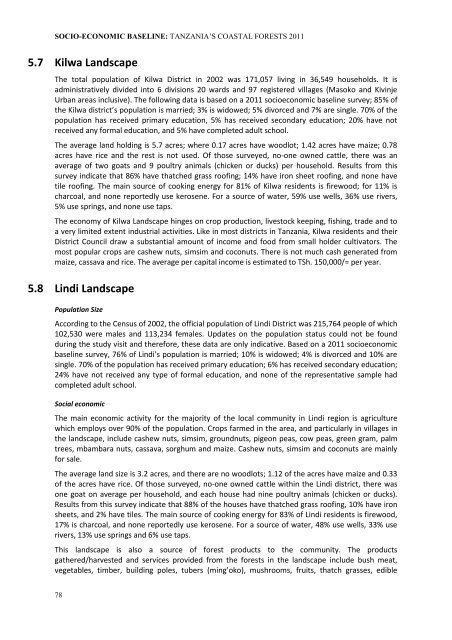Neil D. Burgess, Paul Harrison, Peter Sumbi, James Laizer, Adam ...
Neil D. Burgess, Paul Harrison, Peter Sumbi, James Laizer, Adam ...
Neil D. Burgess, Paul Harrison, Peter Sumbi, James Laizer, Adam ...
Create successful ePaper yourself
Turn your PDF publications into a flip-book with our unique Google optimized e-Paper software.
SOCIO-ECONOMIC BASELINE: TANZANIA’S COASTAL FORESTS 2011<br />
5.7 Kilwa Landscape<br />
The total population of Kilwa District in 2002 was 171,057 living in 36,549 households. It is<br />
administratively divided into 6 divisions 20 wards and 97 registered villages (Masoko and Kivinje<br />
Urban areas inclusive). The following data is based on a 2011 socioeconomic baseline survey; 85% of<br />
the Kilwa district’s population is married; 3% is widowed; 5% divorced and 7% are single. 70% of the<br />
population has received primary education, 5% has received secondary education; 20% have not<br />
received any formal education, and 5% have completed adult school.<br />
The average land holding is 5.7 acres; where 0.17 acres have woodlot; 1.42 acres have maize; 0.78<br />
acres have rice and the rest is not used. Of those surveyed, no-one owned cattle, there was an<br />
average of two goats and 9 poultry animals (chicken or ducks) per household. Results from this<br />
survey indicate that 86% have thatched grass roofing; 14% have iron sheet roofing, and none have<br />
tile roofing. The main source of cooking energy for 81% of Kilwa residents is firewood; for 11% is<br />
charcoal, and none reportedly use kerosene. For a source of water, 59% use wells, 36% use rivers,<br />
5% use springs, and none use taps.<br />
The economy of Kilwa Landscape hinges on crop production, livestock keeping, fishing, trade and to<br />
a very limited extent industrial activities. Like in most districts in Tanzania, Kilwa residents and their<br />
District Council draw a substantial amount of income and food from small holder cultivators. The<br />
most popular crops are cashew nuts, simsim and coconuts. There is not much cash generated from<br />
maize, cassava and rice. The average per capital income is estimated to TSh. 150,000/= per year.<br />
5.8 Lindi Landscape<br />
Population Size<br />
According to the Census of 2002, the official population of Lindi District was 215,764 people of which<br />
102,530 were males and 113,234 females. Updates on the population status could not be found<br />
during the study visit and therefore, these data are only indicative. Based on a 2011 socioeconomic<br />
baseline survey, 76% of Lindi’s population is married; 10% is widowed; 4% is divorced and 10% are<br />
single. 70% of the population has received primary education; 6% has received secondary education;<br />
24% have not received any type of formal education, and none of the representative sample had<br />
completed adult school.<br />
Social economic<br />
The main economic activity for the majority of the local community in Lindi region is agriculture<br />
which employs over 90% of the population. Crops farmed in the area, and particularly in villages in<br />
the landscape, include cashew nuts, simsim, groundnuts, pigeon peas, cow peas, green gram, palm<br />
trees, mbambara nuts, cassava, sorghum and maize. Cashew nuts, simsim and coconuts are mainly<br />
for sale.<br />
The average land size is 3.2 acres, and there are no woodlots; 1.12 of the acres have maize and 0.33<br />
of the acres have rice. Of those surveyed, no-one owned cattle within the Lindi district, there was<br />
one goat on average per household, and each house had nine poultry animals (chicken or ducks).<br />
Results from this survey indicate that 88% of the houses have thatched grass roofing, 10% have iron<br />
sheets, and 2% have tiles. The main source of cooking energy for 83% of Lindi residents is firewood,<br />
17% is charcoal, and none reportedly use kerosene. For a source of water, 48% use wells, 33% use<br />
rivers, 13% use springs and 6% use taps.<br />
This landscape is also a source of forest products to the community. The products<br />
gathered/harvested and services provided from the forests in the landscape include bush meat,<br />
vegetables, timber, building poles, tubers (ming’oko), mushrooms, fruits, thatch grasses, edible<br />
78

















